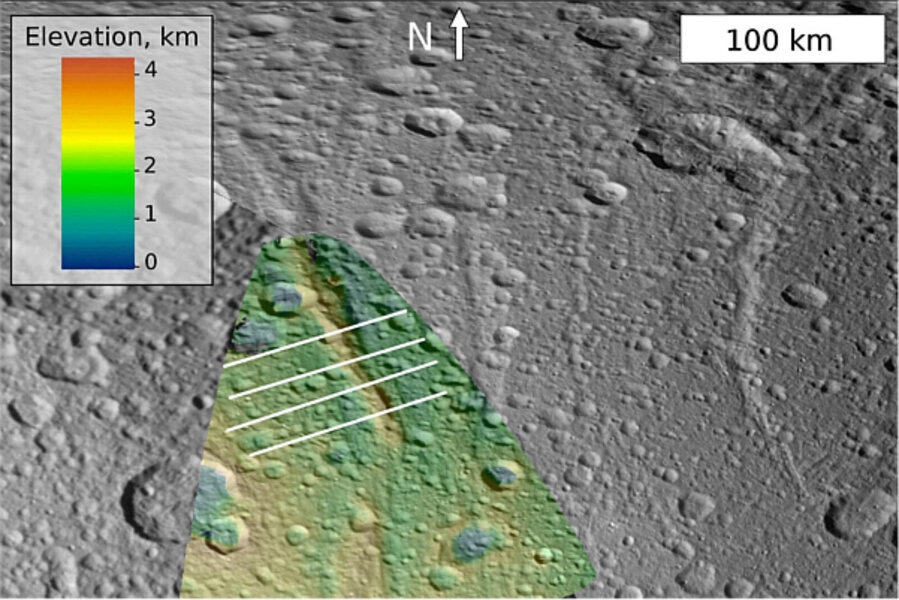Life on Saturn's moon? How a mountain gave clues to a subsurface sea.
Loading...
Dione, one of Saturn's many moons, hasn't attracted a lot of attention before now. It has faded into the near-anonymity of the dozens of other icy satellites orbiting gas giants Jupiter and Saturn. (At last count, Jupiter's up to 66 moons and Saturn has 62.)
But behind its "bland cueball" exterior, Dione might be hiding some secrets of her own – like an ocean anywhere from 5 to 30 miles deep, trapped beneath a frozen surface, according to an article recently published in Icarus.
"The presence of a subsurface ocean at Dione would boost the astrobiological potential of this once-boring iceball," writes Jia-Rui Cook in a NASA press release. Other moons thought to have subsurface seas – like Jupiter's Europa, Ganymede, and Callisto; Neptune's Triton; and Saturn's Titan and Enceladus – are some of the most geologically active worlds in our solar system, she notes. Their activity and hints of liquid water make them fascinating targets for scientist looking for life.
"Maybe one day we'll go to these moons, explore the subsurface oceans, and vacation one day with our jet skis," jokes Noah Hammond, the lead author on the recent study. But until then, he cautions, "evidence for past subsurface oceans on Dione and Rhea [another of Saturn's moons] is tantalizing but far from conclusive."
Dione's liquid-water ocean would be down deep, if it's there. Hammond's team has calculated that Dione has a brittle, frozen-solid outer layer about 2 miles thick (3.5 +/- 1 km), sitting on a thicker layer – probably 30 to 60 miles thick (50-100 km) – "that behaves like a fluid but isn't a liquid," he explains. "It flows over geological time scales," like glass or Earth's own mantle layer. Below that is the liquid ocean, anywhere from 6 to 30 miles (10-50 km) thick, and then a rocky core.
How a mountain revealed a hidden sea
Counter-intuitive though it seems, the secret to this subsurface ocean was in the mountains.
"I noticed that there was an extremely large ridge called Janiculum Dorsa that nobody had really looked at before," says Hammond, who did the research while at SETI Institute and is now at Brown University..
Janiculum Dorsa, an ancient, long, skinny mountain range, reaches about 500 miles long and stands between half a mile and a mile high – more or less the same size and shape as the Blue Ridge Mountains in the southeastern U.S.
Hammond noticed that Dione's surface bends a bit the around the edge of the mountains. "There's a depression on each side of the ridge" he noted. "This looks promising."
A crust capable of bending – flexure, in science-speak – suggests a lot more flexibility than a cold, hard cueball should be capable of.
Think about the difference between setting a bowling ball onto a mattress and a concrete slab. The mattress will sink down under the bowling ball itself (and warp up very slightly all around it), because mattresses can flex. That same bowling ball won't do anything to a concrete slab, since concrete can't bend – and ice shouldn't be any more bendable than concrete.
So when they saw the warping around Janiculum Dorsum, the researchers got excited. How can a cold, icy surface bend?
Radiation from Dione's core didn't release enough heat, so they considered the push-pull of Saturn's gravity tugging on little Dione. First recognized as the driver behind Io's extraordinarily active volcanoes, gravitational pulling, also called tidal flexing or tidal heating, drives most of the interesting behaviors we've found in the outer planets' icy satellites.
It works like kneading play-do. As a small moon swings close to and then far away from its giant planet and fellow moons during its elliptical orbit, it gets yanked this way and that. Just like Earth's moon tugs on our oceans, pulling tides higher and lower, so Jupiter and Saturn haul on their moons (and their moons pull on each other) – but instead of sloshing water up and down, they're actually kneading the whole planetary surface. And just like kneading bread dough (or play-do), the more you work it back and forth, the softer it gets, and the more willing it is to flex and bend.
When Jupiter twists and tugs Io like this, the tidal forcing rips open volcanoes. When Saturn and nearby moon Enceladus knead Dione, it softens the surface a little.
But not enough. Hammond and his colleagues ran the numbers, and they found that tidal heating just couldn't relax icy Dione's surface enough to flex around the mountains (unless the orbit used to be a lot more eccentric than it is now) – until they added water. And that's when it got really exciting.
The only way gravitational tugging can make Dione warm enough to produce the kind of flexure they'd measured around Janiculum Dorsum is if the icy outer surface was riding on something warmer – like an underground ocean.
"Dione probably had an ocean at the time these tectonic features were forming," says Hammond, "if this heat flux we calculated was generated by tidal heating." Since these mountains formed about 4 billion years ago, he adds, "that's not to say Dione has an ocean now…. But maybe early in its history, it had an ocean."
This discovery adds Dione to the growing list of moons that just might have – or at least, once had – subsurface oceans. As Bonnie Buratti of NASA's Jet Propulsion Laboratory said in a press release, "There may turn out to be many more active worlds with water out there than we previously thought."
So far, scientists don't know exactly what Dione's subsurface looks like. Was it once liquid but now frozen solid? Has it stayed slushy? Is there a rock-ice slurry? Is there still a liquid ocean, under a thickening surface layer of ice?
Dione has released some other intriguing clues. Cassini's magnetometer recently spotted evidence of oxygen streaming from the icy moon. And then images revealed fractures like those oozing gas and water ice on Enceladus, another one of Saturn's moons.
"We're still in the process," says Hammond. "Which is a fun place to be."








